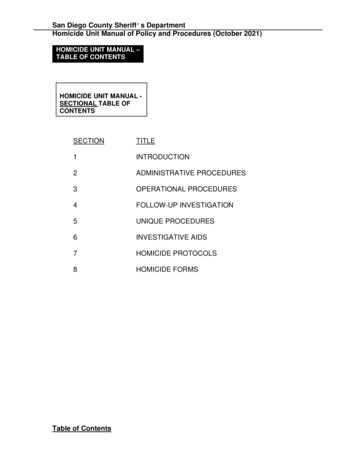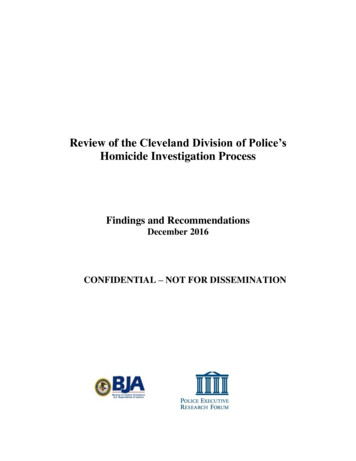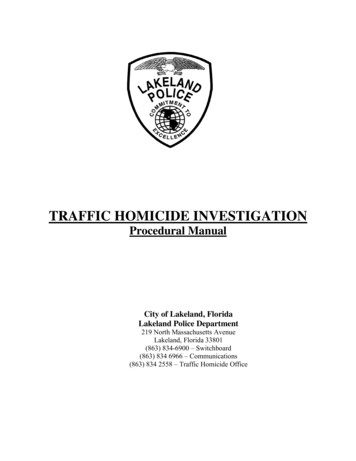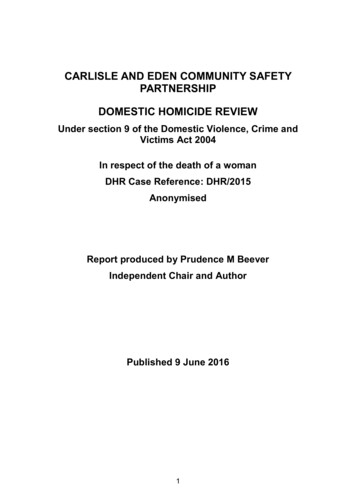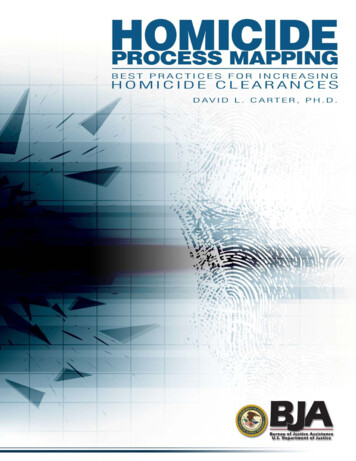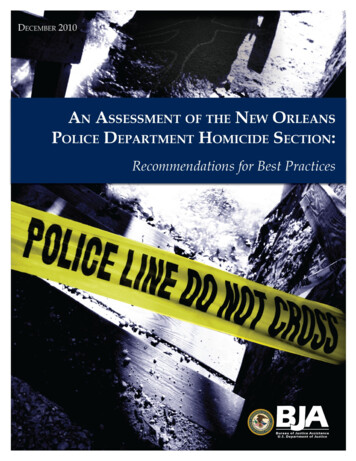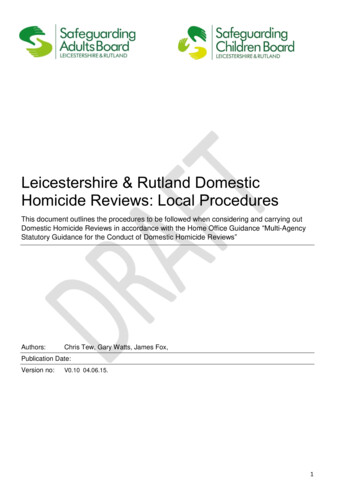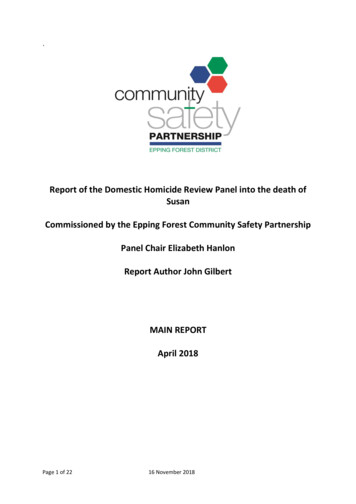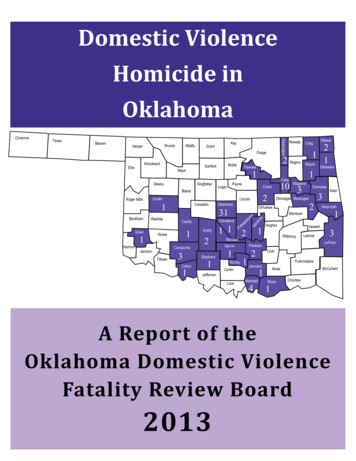
Transcription
Domestic ViolenceHomicide ackson2Oklahoma3Cotton1Grady2Stephens11 okeeOkmulgee loreCoal1 h1211WagonerOkfuskeeemiatowattPoOttawaCraig10 3CreekLincolnCanadian1BeckhamTulsaPayneCusterRoger Mills2 EllisNowataPushmatahaMcCurtainAtokaBryanChoctaw1A Report of theOklahoma Domestic ViolenceFatality Review Board2013
Domestic Violence Homicide in Oklahoma Annual Report 2013Executive SummaryDear Stakeholder,The Oklahoma Domestic Violence Fatality ReviewBoard (ODVFRB) was established in July, 2001,pursuant to O.S. 22 §1602. The board is aneighteen-member multidisciplinary teamcomposed of representatives from state agenciesand other organizations, agencies andassociations who convene eleven times each year(two of which are joint meetings with the ChildDeath Review Board [CDRB]), to review domesticviolence fatalities in Oklahoma and proposerecommendations to improve and coordinate theresponse across the multiple systems that servevictims of domestic violence in our state.Domestic violenceis a serious crimethat affectsthousands ofOklahoma familieseach year. We mustcontinue to raiseawareness of theproblem and findnew ways toprevent and endthe cycle ofviolence.”The board tracks and catalogs homicides meetingthe statutory definition of domestic violence,including victims killed by partners and expartners; family members killed by familymembers; children killed by intimate partnerperpetrators or other family members;Oklahoma Attorneybystanders killed by intimate partnerGeneralperpetrators; roommates killed by roommates;and suicide deaths of intimate partnerE. Scott Pruittperpetrators. Ongoing case reviews and trendanalyses continue to shed light on the gaps thatexist in our systems and serve to inform the development of recommendations to closethese gaps. It is the objective of the board that recommendations serve as anopportunity for our legislature, state agencies, and community organizations tocontinue to review and update policies, protocols, administrative procedures andprofessional practices in order to better serve victims of domestic violence and theirchildren. Recommendations encourage systems to work together to achieve positiveoutcomes for victims. Ultimately, the long-term goal is to strengthen the safety net forvictims and prevent domestic violence homicide in Oklahoma.In addition to identifying gaps, case reviews also highlight the leadership, vision andcommitment of Oklahoma’s many agencies and the exceptional service of the dedicatedprofessionals serving victims in our state - every day - the “unsung heroes”.Thank you for your support.Cover: The highlighted counties and numbers represent the 109 men, women, and children who died asa result of domestic violence in Oklahoma in 2012, as compiled by the Oklahoma Domestic ViolenceFatality Review Board.20131
Domestic Violence Homicide in Oklahoma Annual Report 2013Contents2012 Domestic Violence Fatalities in Oklahoma by County .32012 Domestic Violence Fatalities in Oklahoma .42012 Intimate Partner Fatalities (IPV) Specific .9Protective Orders (PO) and Victims InformationNotification Everyday (VINE) .102013 Recommendations .11Update on Past Recommendations and Achievements 12Acknowledgements 142012 Domestic Violence Fatality Review Board Members . .1520132
Domestic Violence Homicide in Oklahoma Annual Report 20132012 Domestic Violence Fatalities in Oklahoma by icide(Perpetrator Died/Victim Survived)111111262112188 Victims 16 Perpetrators5 Perpetrators20133
Domestic Violence Homicide in Oklahoma Annual Report 20132012 Domestic Violence Fatalities in OklahomaDomestic Violence homicide in Oklahoma in2012 emerged from the backdrop of thestate’s 2011 ranking of 3rd in the nation forwomen killed by men in single victim, singleoffender homicides (Violence Policy Center,2013). In addition, the Centers for DiseaseControl‘s, National Violence Against Women2010 Survey, found that the lifetimeprevalence of rape, physical violence, and/orstalking towards women by an intimatepartner to be greater in Oklahoma than in anyother state.In 2012, a total of 219 homicides, of which 53were classified as domestic abuse murders,were reported by various law enforcementagencies to the Oklahoma Bureau ofInvestigation; 73.1% of the reportedhomicides involved a firearm (State ofOklahoma Uniform Crime Report [UCR],2012).Spotlight onDomestic Violence inOklahomaData from the OklahomaState Bureau ofInvestigation (OSBI), Crime inOklahoma 2012 report,selected findings on domesticabuse crimes in Oklahomainclude:Domestic Violence byOffenseMurder .53Sex Crimes .931Domestic Violence FatalitiesAssault .2,354In this same year, the Domestic ViolenceFatality Review Board identified109 women,men and children who lost their lives inOklahoma as a result of domestic violence.Assault & Battery .21,942Oklahoma is ranked 3rdin the nation for women killedby men in single victim,single offender,homicides.Violence Policy Center2013Total .25,280Law enforcementresponded to 2,354incidents of domesticabuse-relatedassaults in 2012Source: Oklahoma State Bureauof Investigation (OSBI), State ofOklahoma, Uniform CrimeReport, 201220134
Domestic Violence Homicide in Oklahoma Annual Report 20132012 Domestic Violence Fatalities in OklahomaIn 2012, the Oklahoma Domestic Violence FatalityReview Board (DVFRB) identified 109 people inOklahoma who lost their lives as a result of domesticviolence. These deaths include domestic violencevictims killed by partners and ex-partners; familymembers killed by family members, children killed byabusers or other family members; bystanders killed byabusers; roommates killed by roommates; and suicidedeaths of abusers.Of the 109 people who died, 88 were identified ashomicide victims and 21 were identified as homicideperpetrators who died as a result of suicide or lawenforcement/bystander intervention (Figure 1). Of the91 perpetrators, 21 (23%) died as a result of suicide orsuicide by police/bystander intervention.109People LostTheir Lives As AResult OfDomesticViolenceFigure 1. Domestic Violence-Related Deaths21 (19%)PerpetratorsVictimsPerpetrators88 (81%)Victims20135
Domestic Violence Homicide in Oklahoma Annual Report 201362012 Domestic Violence Fatalities in Oklahoma2012 Victim Demographics2012 Victim GenderFigure 2. Victims By Gender 2012Of the 88 victims, 43 (49%)were female and 45 (51%)were male (Figure 2).45(51%)2012 Victim AgeThe youngest victim, killed byhis father, was two months old.The oldest victim, killed by hernephew, was 89 years old(Figure 3). Three victims werenot yet born and died as aresult of the death of theirmothers.The average age of victims was34.53.FemaleMaleFigure 3. Victims By Age 20123(3%)10(11%)24(27%)2012 Victim RaceOf the 88 victims, 57 (65%)were Caucasian, 11 (12%)were African American, 9 wereHispanic’/Latino Origin (10%),6 (7%) were Native Americanand 5 (6%) were of unknownrace (Figure 4).43(49%)19(22%)UnbornUnder 2121 to 4032(36%)41 to 60Over 60Figure 4. Victims By Race Hispanic/Latino57(65%)Native AmericanUnknown2013
Domestic Violence Homicide in Oklahoma Annual Report 20132012 Domestic Violence Fatalities in Oklahoma2012 Perpetrator Demographics2012 Perpetrator GenderFigure 5. Perpetrators By Gender 2012Of the 91 perpetrators, 70(77%) were male and 21(23%) were female (Figure5).21(23%)Male70(77%)2012 Perpetrator AgeOf the 91 perpetrators, 7(8%) were under 21, 48(53%) were 21 to 40, 28(31%) were 41 to 60, 6 (7%)were over 60, and 2 (2%)were of unknown age (Figure6).Figure 6. Perpetrators By Age 20122(2%)6(7%)Of the 91 perpetrators, 42(46%) were Caucasian, 21(23%) were AfricanAmerican, 11 (12%) wereNative American, 6 (7%)were Hispanic/Latino Origin,1 (1%) was Asian and 10(11%) were of unknown race(Figure 7).7(8%)Under 2121 to 4028(31%)The average age ofperpetrators was 38.12.2012 Perpetrator RaceFemale48(53%)41 to 60Over 60UnknownFigure 7. Perpetrators By Race 201216 (1%)(7%)10(11%)11(12%)21(23%)CaucasianAfrican American42(46%)Native AmericanHispanic/LatinoAsianUnknown20137
Domestic Violence Homicide in Oklahoma Annual Report 20132012 Domestic Violence Fatalities in OklahomaIn 2012, victims were killed withfirearms (58%), knife/cuttinginstruments (17%), blunt force(14%), automobiles (3%),drowning (2%), strangulation(2%), fire (1%), neglect (1%)and other (1%).Domestic Violence HomicideandFirearmsPerpetrators who committedsuicide or suicide bypolice/bystander interventionfollowing the murder wereoverwhelmingly killed byfirearms (81%), hanging (9.5%)and knife/cutting instruments(9.5%) (Figure 8).81% of perpetrators were killed(suicide or suicide bypolice/bystander intervention)58% of victims were killed byfirearmsFigure 8. Domestic Violence Homicide by Weapon gInstrument1517Firearm01020513040506020138
Domestic Violence Homicide in Oklahoma Annual Report 20132012 Domestic Violence Fatalities in OklahomaIntimate Partner Violence Fatalities Specific (IPV)Approximately 1 in 2.2 (45%) domestic violence homicides in Oklahoma wasclassified as an intimate partner (IPV) homicide.Of the 88 domestic violence victims, 40 were killed by domestic violence abusers.The youngest intimate partner victim, killed by her boyfriend, was 15 years old. Theoldest intimate partner victim, killed by his wife, was 89 years old. The average ageof intimate partner victims was 38.9.Three (3%) Intimate Partner Victims Were Pregnant At The TimeOf Their Death.Women were more likely than men to be killed by an intimate partner. Twentyseven (68%) intimate partner homicide victims were female and 13 (32%) weremale. Twelve (30%) intimate partner homicide perpetrators were female andtwenty-eight (70%) were male (Figure 9).30Figure 9. Intimate Partner (IPV) Homicide Victims by %)50Intimate Partner VictimsIntimate Partner Perpetrators20139
Domestic Violence Homicide in Oklahoma Annual Report 20132012 Domestic Violence Fatalities in OklahomaProtective Orders (PO) and Victims Information NotificationEveryday (VINE)We found no evidence that any of the intimatepartner victims had ever participated in theVictims Information Notification Everyday (VINE)program.In addition, only 1 of the 88 intimate partnervictims had a current protective order against theperpetrator; 6 had a protective order against theperpetrator in the past.Of the intimate partner perpetrators, 18 had priorprotective orders against them from other people;and 7 of the intimate partner victims hadprotective orders against them from thisperpetrator (Based on Oklahoma data only).Very Few Homicide Victims ReceivedDomestic Violence Services from anAttorney General Certified AgencyIn 2012, only 5 (6%) of the 88 homicide victimsreceived services from an Attorney Generalcertified Domestic Violence Service ProviderAgency prior to the death. These services rangedfrom just a hotline call for some to residing in anemergency shelter for others. (Data is from asurvey of certified domestic violence serviceprovider agencies).“There isn’t one homicide preventioncenter in America. And the closest wehave to a homicide prevention centeris a battered women’s shelter becausewhat they’re dealing with is peoplewho, if interventions are not appliedwisely, are likely to be killed.”Gavin de Becker from“The Gift of Fear”Spotlight onAttorney GeneralCertified DomesticViolence VictimService ProviderAgencies inOklahomaIn 2012 Total number of certifiedvictim service agencies28Total number of victimsserved in certified victimservice agencies13,218Total number of shelterdays102,917Total number of hotlinecalls15,214Total number of womenturned away fromshelter because ofcapacity2,488201310
Domestic Violence Homicide in Oklahoma Annual Report 2013Recommendations to Improve System Response to DomesticViolence and Prevent Homicide2013 RecommendationsDepartment of Human Services (OKDHS) (Human & SocialServices)1. To encourage safety for victims of domestic violence and their children who arein contact with the child welfare system in Oklahoma and to strengthen OKDHScapacity to provide effective assessment and intervention for familiesexperiencing domestic violence, OKDHS should create an internal positionwithin the agency to act as a liaison between OKDHS and Attorney GeneralCertified Domestic Violence Agencies.The position should act as a liaison to help coordinate domestic violence servicesfor families, advance collaborative relationships between OKDHS and AttorneyGeneral Certified Domestic Violence Victims and Batterers Intervention Services,and should understand best practices related to domestic violence for workingwith families experiencing domestic violence.Health Care1. Using the National Consensus Guidelines on Identifying and Responding toDomestic Violence Victimization in Health Care erfiles/file/Consensus.pdf),educate/train all healthcare providers in: Traumatic nature of domestic violence & post-traumatic stressdisorderOklahoma’s domestic violence reporting lawAssessment of domestic violenceReferral to appropriate services for careDocumentation in the medical record2. All health care providers should be familiar with current domestic violencereporting laws. 22 Okl.St.Ann. § 58, which can be found at the following Document.asp?CiteID 442192**For a simplified discussion of the requirements of the law, see Oklahoma’sNursing Times etter view.asp?newsid 2642 &catid 256&active 0 **201311
Domestic Violence Homicide in Oklahoma Annual Report 2013Update on Past Recommendations and AchievementsMaking a Difference in OklahomaSince 1998, the DVFRB has submitted recommendations based on their case reviewand analysis of trends. Recommendations are centered on system improvements,ranging from increased awareness, and training for allied professionals, policy andprotocol considerations for the court system, law enforcement, child welfare,batterer intervention programs and others. Always, the goal is to close safety gapsacross the multiple systems that intersect with victims of domestic violence andtheir children.Past DVFRB RecommendationImplement training for Mental Health Professionals in OklahomaFindings from the DVFRB show that homicide victims consistently come into contactwith mental health professionals prior to their deaths. One specific finding fromreviewed cases (1998 to 2012), revealed that 40% of couples had contact with theDepartment of Human Services and/or the Department of Mental Health andSubstance Abuse Services prior to the death. In efforts to promote safety for victims,training recommendations for mental health professionals have been made by theDVFRB and others spanning several years.In November, 2012, an interim study was conducted as an initiative recommendedby the DVFRB to determine the need for this training in Oklahoma. The interimstudy determined that mental health professionals would benefit from havingaccess to introductory training in domestic violence. Under the direction of a DVFRBmember, the interim study led to the development of a Mental Health and DomesticViolence Committee comprised of multiple mental health and substance abuseagencies and organizations in Oklahoma including the Oklahoma Department ofMental Health and Substance Abuse Services (ODMHSAS). Other partners includedthe Oklahoma Office of the Attorney General, Victim Services Unit (DVFRB) togetherwith the Oklahoma Coalition Against Domestic Violence and Sexual Assault and theYWCA Oklahoma City.Committee activities include an ODMHSAS led project to develop a web-basedonline domestic violence training for mental health and substance abuseprofessionals as well as a “domestic violence liaison” project which places a liaisonin all ODMHSAS contracted agencies in the state. The role of the liaison is tocoordinate safe referrals to OAG certified domestic violence service providers and toprovide a link between the two service systems.201312
Domestic Violence Homicide in Oklahoma Annual Report 2013Update on Past Recommendations and AchievementsPast DVFRB RecommendationTraining for Oklahoma Department of Human Services WorkersIn 1999, the National Council of Juvenile and Family Court Judges (NCJFCJ)presented principles of “safety, well-being, and stability for all victims of familyviolence and the need to hold batterers accountable for their violence” ((NCJFCJ,1999 p. 6). The project included recommendations developed from diverse socialand legal systems and with strong representation from judicial leaders. Therecommendations have come to be known as the “Greenbook Recommendations”(NCJFCJ, 1999). An understanding that successful collaborations are built through“cross-communication” and cross- training for system partners is central to thedevelopment of these recommendations. In efforts to promote safety for victims,training recommendations for the Department of Human Services have been madeby the DVFRB spanning several years.In July, 2012, the Oklahoma Department of Human Services released the “DomesticViolence Manual for Child Welfare Professionals: A Desk Reference Guide”. Theinitiative to develop a best practice guide for workers was the result of a year- longcollaborative effort between the department and external stakeholders, includingstate and local experts in the field of domestic violence. The reference guide isdisseminated to child welfare workers across the state and is used extensively intraining to assist workers with screening, safety planning and danger/lethalityassessment at the very complex intersection of child maltreatment and domesticviolence. The overall goal of this initiative was to encourage safety for those victimsof domestic violence and their children who are in contact with the child welfaresystem in Oklahoma.Past DVFRB RecommendationTraining for Batterer Intervention ProgramsIn 2012, the DVFRB made a recommendation for Attorney General Certified BattererIntervention Programs (BIP’s) to conduct lethality assessment/reassessmentthroughout participation in the program. The Office of the Attorney General’s VictimServices Unit created a “BIP Training Committee” comprised of several agencies anddomestic violence experts in the state to conduct Batterer Intervention Training forCertified BIP program managers and facilitators The committee developed a 16hour training curriculum. So far, approximately 150 BIP program staff haveparticipated in this training. This initiative continues to grow. A list of AttorneyGeneral Certified Batterer Intervention Programs can be found at the following l201313
Domestic Violence Homicide in Oklahoma Annual Report 2013AcknowledgementsThe members of the Domestic Violence Fatality Review Board and the staff of theOklahoma Office of Attorney General gratefully acknowledge the time and effortrendered during this project. The outcomes of this project would not have beenpossible without the gracious cooperation and collaboration of the officials and theirstaffs acknowledged here:· Oklahoma State Bureau of Investigation· Office of the Chief Medical Examiner· Oklahoma Department of Human Services· Oklahoma State Department of Health· Oklahoma Department of Mental Health and Substance Abuse Services· Oklahoma Office of Juvenile AffairsMany thanks to all of the County Sheriffs, Police Chiefs, District Attorneys, CourtClerks and their staffs who have helped us gather the case materials. We realizemany of you already are pushing the boundaries of time and we appreciate yourhard work. A special thanks to the Oklahoma Violence Against Women Act Boardthrough the Oklahoma District Attorneys Council. The S.T.O.P. Violence AgainstWomen Act Grant funds this project. Without this support, this project would not bepossible.Special thank you to Brandi Woods-LittleJohn for her work as the Program Managerfor the Oklahoma Domestic Violence Fatality Review Board from 1998 to 2013 andfor the design and presentation of many aspects of this report. Her efforts havemade a difference to victims of domestic violence in Oklahoma.Staff must also acknowledge the Washington State Coalition Against DomesticViolence for inspiring the new presentation of data in this report.201314
Domestic Violence Homicide in Oklahoma Annual Report 2013152012 Domestic Violence Fatality Review Board MembersOffice RepresentedMemberDesigneeListed Directly In StatuteChief Medical ExaminerEric Pfeiffer, M.D.Commissioner of the Department ofMental Health & Substance AbuseServicesTerri White, M.S.W.Karen FrensleyState Commissioner of HealthTerry Cline, Ph.D.Patricia DamronChief of Injury Prevention Service,Oklahoma State Department of HealthPam Archer, MPA, ChiefOklahoma State Bureau of InvestigationStan Florence, DirectorSheryll Brown, MPHAndrea HamorEdmondsonPat DamronBeth GreenOffice of the Attorney GeneralScott Pruitt, AttorneyGeneralOklahoma Department of HumanServicesHoward H. Hendrick, Dir. Casey HalfordOffice of Juvenile AffairsGene Christian, JDLesley March, ChiefVictim Services UnitFara BrownDonna Glandon, JDAppointed by the Attorney General of Oklahoma for two-year termsOklahoma Sheriffs AssociationOklahoma Assoc. of Chiefs of PoliceOklahoma Bar AssociationDistrict Attorneys CouncilOklahoma State Medical AssociationOklahoma Osteopathic AssociationOklahoma Nurses AssociationOklahoma Supreme CourtOklahoma Coalition Against DomesticViolence & Sexual AssaultDVFRB StaffOklahoma Domestic Violence FatalityReview BoardCounty SheriffChief of PolicePrivate AttorneyDistrict AttorneyPhysicianPhysicianNurseDistrict JudgeSurvivorCitizenCitizenMike Booth, SheriffW. Don Sweger, ChiefG. Gail Stricklin, J.D.Jeff Smith, District 16Martina Jelley, M.D (Chair)Lori Hake, D.O.Janet Wilson, Ph.D., RNDan Allen, J.D.Shelly CollinsMarcia Smith, DirectorSunshine GrossBrandi Woods-LittleJohn,Program Manager2013
Domestic Violence Homicide in Oklahoma Annual Report 2013Oklahoma DomesticViolence Fatality ReviewBoardOklahoma Office of Attorney General313 N.E. 21st StreetOklahoma City, OK 73105Phone: 405-522-1984Fax: 405-557-1770Email: Jacqueline.Steyn@oag.ok.govPlease go tohttps//www.oag.ok.gov· This report· Enabling Legislation· The DVFRB Mission, Purpose andDefinitions· Methods and Limitations of datacollection and data· History of the BoardPlease disseminate thisreport widely.16If you or someone you know needs help in aDomestic Violence situation, please call:Safeline1-800-522-SAFE (7233)If you need general information aboutDomestic Violence, please call:Oklahoma Coalition Against DomesticViolenceand Sexual Assault – (405) 524-0700The Office of the Attorney General,Victim Services Unit – (405) 521-3921If you need more information aboutthe Oklahoma Domestic ViolenceFatality Review Board, please call:The Office of the Attorney General(405) 522-1984If you are in an emergencysituation please dial 9-1-1immediately.Publication prepared by the Oklahoma Office of Attorney General, E. Scott Pruitt on behalfof the Oklahoma DomesticViolence Fatality Review Board, 2013.Written by:Jacqueline Steyn, Program ManagerClaire Collins, InternWith assistance from Lesley March, Chief,Victim Services Unit, and StaffThis project was supported by subgrant No. V12-015, awarded by the Office on ViolenceAgainst Women, US Department of Justice. The opinions, findings, conclusions, andrecommendations expressed in this publication are those of the author(s) and do notnecessarily reflect the views of the Department of Justice, Office on Violence AgainstWomen.2013
Domestic Violence Homicide in Oklahoma Annual Report 2013 8 0 10 20 30 40 50 60 Firearm Knife/Cutting Instrument BFT Automobile Drowning Strangulation Fire Neglect Hanging Other Perpetrator Victim 51 17 15 2 12 3 2 2 1 1 2 1 Figure 8. Domestic Violence Homicide by Weapon 2012 Domestic Violence Homicide and Firearms 58% of victims were killed by .
